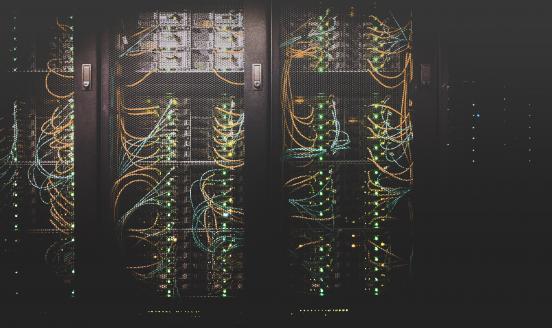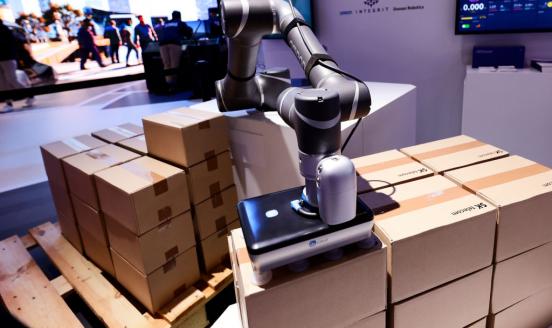Artificial intelligence in the fight against COVID-19
Artificial intelligence can help fight the coronavirus through applications including population screening, notifications of when to seek medical help

In the face of the coronavirus, digital technologies are vital for both social health and economic performance. A digital response to the COVID-19 pandemic can take multiple forms and bring significant value. One important area in which there have been rapid developments in the last few weeks is new applications of artificial intelligence (AI) and machine learning (ML) for screening of the population and assessing infection risks.
Screening the population to identify who is potentially ill is crucial for containing COVID-19. In China, which was hit first, traditional infrared imaging scanners and handheld thermometers were introduced in multiple public locations, especially in Beijing. Chinese AI champion firms have now introduced more advanced AI-powered temperature screening systems in places including subway and railway stations. The advantage of these systems is that they can screen people from a distance and within minutes can test hundreds of individuals for fever.
In China and elsewhere, new AI-powered smartphone apps are being developed to monitor individual’s health and track the geographical spread of the virus. Such apps aim to predict which populations and communities are most susceptible to the negative impacts of a coronavirus outbreak, to enable patients to receive real-time waiting-time information from their medical providers, to provide people with advice and updates about their medical condition without them having to visit a hospital in person, and to notify individuals of potential infection hotspots in real time so those areas can be avoided.
Data access
These technologies generally need access to data transmitted by mobile phones, including locational data. While the tools are being developed, it is important to also develop a framework so they can be as effective as possible in practice. For this, close coordination between authorities, telecoms operators, high-tech industry and research institutions is needed. High-tech firms and leading universities can provide the tools, telecoms firms can provide access to individuals’ data, and authorities should ensure that data sharing conforms with privacy rules and does not create risks the data of individuals will be misused.
For example, in Belgium, datasets from telecoms operators are combined with health data under the supervision of the Belgian Data Protection Authority in order to generate aggregate and anonymised regional-level datasets that can be used to assess how the virus spreads and which areas are high risk. Similar initiatives are underway in other countries. The real value of these efforts is that digital technologies can offer monitoring in real-time, enabling authorities to be more proactive.
In Austria, the largest telecom operator reached an agreement with the authorities to provide anonymised data, while, a similar anonymised customer data-sharing mechanism has been put in place to track and analyse population movements in Italy’s hard-hit Lombardy region.
Privacy-protecting applications
Academic research can also be helpful in illustrating how information sharing can be designed while avoiding privacy risks. The Human Dynamics Group at MIT Media Lab for example, has worked extensively with smartphone data to analyse the behaviour of individuals while respecting high privacy standards. It recommends secure multiparty computation to preserve users’ privacy.
MIT’s privacy-friendly data mechanisms could be a basis for designing a data-sharing model to limit the spread of COVID-19. A consortium of epidemiologists, engineers, data scientists, privacy activists, professors and researchers from different parts of the world are working on an open-source smartphone app to prevent the spread of the virus without building a surveillance state. The app checks for overlaps of users’ GPS trails with the trails of all infected patients (whose anonymised data is provided by health authorities), while cryptographic methods are used and there is no sharing of raw data (personal data does not leave the device). This system provides early alerts and personalised information that allow individuals who signed up to the app to understand their own exposure and risks, based on earlier contact with infected patients. Such services can only be effective if a great number of patients and other individuals subscribe.
With such information as an input, research on (social) networks is trying to forecast how and to what extent the virus will spread, given a set of pre-determined parameters and characteristics. Authorities can use these scenarios to prepare their contingency plans in time.
Using information on the time individuals spend in a particular location and on the number of infections that occur there, scientists create spatial models that depict the evolution of contacts between infected people, in order to capture how transmission evolves. One of the preliminary findings of such efforts is that predicting the transmission of COVID-19 is trickier than for previous viruses because individuals can carry the virus without showing symptoms, and their infections are therefore difficult to detect. A large number of the infections in Wuhan seem to have been transmitted through such asymptomatic carriers (Stanford’s Lin Lab estimates that 50% of infected individuals are asymptomatic). So, intensive COVID-19 testing programmes (like that implemented in South Korea) can be helpful by providing data for the better performance of these models.
AI can also be applied to the automatic detection and removal of misinformation related to the virus posted on social networks; producing highly accurate and timely CT scans for the detection of virus-induced pneumonia; 3D printing to produce the tools needed for intensive healthcare; optimisation of clinical trials of drugs and potential vaccines; development of robotic systems to sanitise infected areas; and online systems for the medical examination of individuals.
Timing is of course critical (a study on the 1918 influenza pandemic shows that US cities that adopted non-pharmaceutical measures at an early phase had peak death rates 50% lower than those that did not). Governments have been criticised for failing to understand the severity of the coronavirus situation and not imposing coordinated measures in time.
While the AI community is working intensively on delivering applications that can help to contain the virus, AI systems are still at a preliminary stage and it will take time before the results of such AI measures are visible. We are still far from the end of this tragic story.



